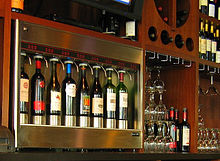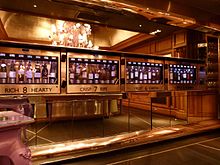Enomatic wine dispenser: Difference between revisions
Encycloshave (talk | contribs) m →External links: Added two categories |
Frequencydip (talk | contribs) →External links: removed spam |
||
| Line 58: | Line 58: | ||
== External links == |
== External links == |
||
* [http://www.enomaticusa.com/ Official Enomatic site (English)] |
|||
* [http://www.enomaticusa.it/ Official Enomatic site (Italian)] |
|||
* [http://www.enomatic.it/new/default.asp?catIDPadre=33&catID=34&NewsLan=ENG/ Official Enomatic site (French)] |
|||
* {{Twitter|EnomaticUSA|Enomatic}} |
|||
* {{Facebook|Enomaticusa|Enomatic}} |
|||
<!--- Categories ---> |
<!--- Categories ---> |
||
Revision as of 23:28, 16 February 2012
 | |
| Inventor | Lorenzo Bencistà Falorni[1] |
|---|---|
| Company | Enomatic |
| Place | Greeve in Chianti, Florence, Italy in the heart of Chiantishire (2002) |
| Website | enomatic.com |
| Weight | 88.2 lbs Enoline Classic 4-bottles |
| Industry | Wine, Wine tasting, hospitality business solutions, serving systems |
A Wine Dispenser is an Italian invention developed in 2002 by a Tuscan entrepreneur. It preserves wine for more than three weeks after the bottle has been opened and while providing serving by the glass.[2]
History
The machine was invented in 2002 by Lorenzo Bencistà Falorni[3] to allow people to select among a large amount of bottles through tasting by the glass. The first dispensers were assembled in 2000, in a garage, and in the following months 7 circular prototype machines[4] were produced.
Lorenzo Bencistà Falorni then completely restored an ample 19th century space in Greve in Chianti.[5] The so-called Enoround, were installed, making 112 self-serving wines continuously available to visitors. The "Cantine di Greve" consequently became the most important point of sale for Tuscan wines in the area.[6]
Though few can afford a bottle of Château Margaux, many can grant themselves the pleasure of sipping a glass! Without Enomatic's technology the possibility of finding a Premier Cru by the glass would be nil...
says Lorenzo Bencistà Falorni.[7]
Enomatic systems core innovation is to enable wine preservation using inert gas preservation. It is the first and only wine dispenser to have received two accreditations.[8][9] The Consorzio carried out laboratory analyses to trace the evolution of the principal parameters of wine oxidation, and certified the effectiveness of Enomatic's wine preservation system, while the American Sommelier Association, which was contacted as a body of foreign experts, expressed its approval after a series of blind wine tasting. They certified that the flavor and characteristics of the wine remain intact for more than three weeks[10] enabling wine establishments to maximize servings while eliminating waste.[11][12]
Models

The Classic Line is the "historic line" and includes several models: Enoline (a 4 or 8-bottle in-line dispenser), Enomodule (an 8-bottle in-line built-in model that can be mounted in multiple units), Enoellipse (a 16 bottles arranged in an ellipse), Enomove (a mobile unit mounted on a cart, which allows wines to be served directly at table) and Enopoint (a refrigerator unit with 5-bottle integrated dispenser). Élite is the evolution of the Enomatic system. It added touch screen and graphic displays that provide information on the products.[13]
The Wine Card is another Enomatic patent. It allows consumers to taste wines without the assistance of store or bar personnel.[14]
In 2011, Enomatic introduced a new patent for Flûte, the first system that allows Champagne and other sparkling wines to conserve for more than 10 days after being openned.[15] The Flute is also certified by NSF as well as all Elite Dispensers.[16]
References
- ^ Lorenzo Bencistà Falorni awarded among the wine world's 50 most important movers and shakers in 2010
- ^ Picture of an 8-bottle Enomatic in Brussels Airport
- ^ Tuscan Inventor Improves Wine Tasting by the Glass, Italy Magazine, July 30th, 2011
- ^ Consorzio_Chianti_Classico_Certification_may2010_ITA_ENG
- ^ History of the Cantine di Greve
- ^ Le Cantine di Greve in Chianti
- ^ Extract from Enomatic Press Kit 2011 pag.05
- ^ Certification from the United States Sommelier Association
- ^ Consorzio_Chianti_Classico_Certification_may 2010
- ^ Organoleptic Certification issued by The US Sommelier Association (USSA)
- ^ Revolution in the wine bars, retrieved September 2011
- ^ From Tuscany to the world: a revolutionary way to serve and save wine, retrieved July 2011
- ^ Bar di Saluzzo ha aperto il “bancomat del vino”
- ^ Extract from "Viacard in Enoteca" pag.104", Il Mio Vino - Dicembre 2002
- ^ Flute Official Website
- ^ NSF Listing of Enomatic Certifications
